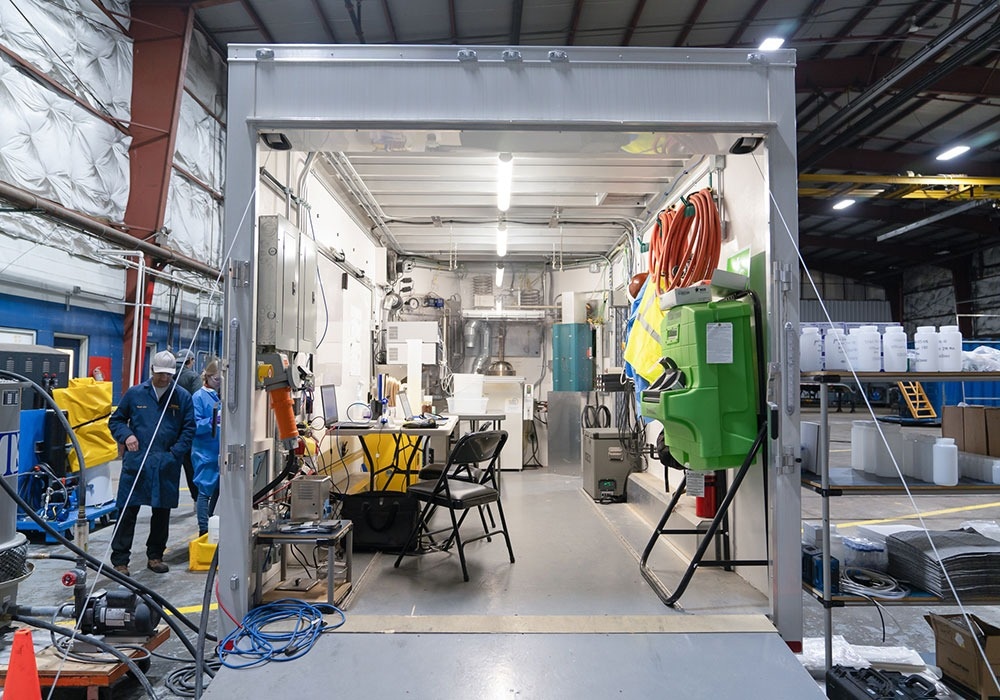Reviewed by Alex SmithJun 21 2022
As the United States struggles to face the issue of PFAS contamination, Battelle offers a proven solution that has the potential to remove the source of contaminated drinking water.

Image Credit: Battelle.
The PFAS ANNIHILATOR™ attacks the source of the chemicals, destroying them and blocking them from entering drinking water systems.
The United States Environmental Protection Agency (EPA) recently issued health advisories for chemical compounds called PFAS, or so-called per- and polyfluoroalkyl substances.
Such human-made chemicals, initially introduced at the time of the World War II as an armor coating, have been adapted for an extensive range of everyday products, such as cosmetics, non-stick cookware, food packaging, paint, firefighting foams, and several other products that are water and oil repellent, friction-reducing, and temperature resistant.
Their durability and usefulness — called “forever chemicals” — is a double-edged sword. At present, they are in the air, water, and soil, and they are very hard to remove.
At present, PFAS are universal in all 50 states in the United States and throughout the world, and the majority of people have them in their bodies. The health effects of some PFAS are connected to thyroid problems, infertility, and various types of cancer.
At present, there are no federally enforced, science-based standards for PFAS regulation, but the EPA liberated a PFAS Strategic Roadmap in October 2021 and determined over 120,000 US locations where people might be exposed to PFAS.
The EPA mid-June advisories for some of the 5,000-plus PFAS compounds came with an indication that the federal agency will start to regulate them in the coming months.
Battelle is ahead of the curve on this problem. During the past decade, we have invested millions of dollars in PFAS research and developed a solution called the PFAS ANNIHILATOR™ to destroy PFAS chemicals.
Amy Dindal, Manager, Environment Division, Battelle
The newly-developed technology has been proven to destroy PFAS by making use of supercritical water oxidation (SCWO), a process that leads to breaking the carbon–fluorine bond that makes them highly durable. The on-site destruction abilities of Battelle have been developed to remove PFAS at the source of contamination prior to getting to drinking water supplies.
The PFAS ANNHILATOR is known to be a scalable technology that has the potential to be portable, mobile, or fixed concerning operating scenarios. Battelle forecasts that a minimum of four units will be in operation by June 2023.
The other techniques available for treating PFAS-contaminated water offer the elimination of PFAS decontamination. However, those techniques frequently produce secondary waste that needs extra landfilling or treatment for the final disposition of the waste.
The Battelle technology destroys PFAS on the whole thereby reducing worries about fulfilling regulatory limits in the future. Furthermore, Battelle offers PFAS laboratory analysis and has been approved for EPA Method 533 and EPA Method 537.1, both drinking water techniques on the EPA’s Unregulated Contaminant Monitoring Rule 5.
At the start, Battelle was concerned with fulfilling sources of PFAS in landfill leachate, firefighting foams (AFFF), and industrial wastewater.
Later in the 2022 summer, the PFAS ANNIHILATOR™ will be on-site in North Carolina to destroy firefighting foam that has high levels of PFAS due to the suppression abilities.
The foams have been utilized for several years in airports, fire departments, military bases, and other sites but are currently being gradually reduced. The ANNIHILATOR™ is known to be a proven non-combustion technology that helps to destroy PFAS in AFFF while worries tend to sustain regarding other treatment and disposal options.
Earlier this 2022, the PFAS ANNIHILATOR™ was dispensed to a facility in Michigan that has been functioned by Heritage-Crystal Clean.
The technology of closed-loop supercritical water oxidation (SCWO) was utilized for the complete destruction of PFAS in landfill leachate that was taken to the site. At present, Battelle is engineering a fixed base unit that will be installed to work at this HCC facility to destroy PFAS in several types of aqueous waste.